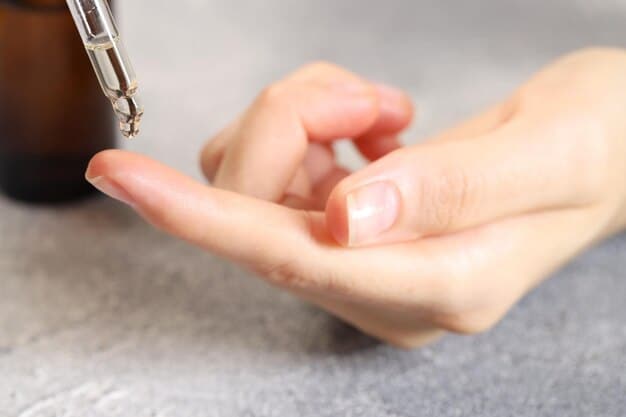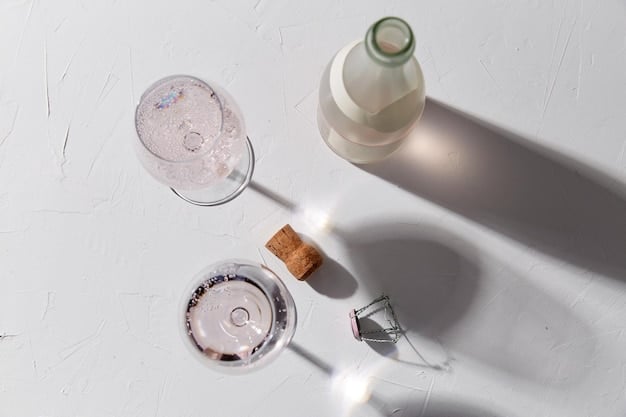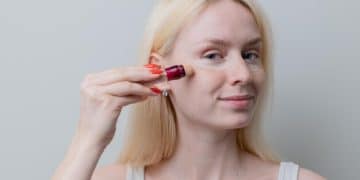Hyaluronic Acid Serum: Right Concentration for Your Skin?

Anúncios
Achieving optimal results with hyaluronic acid serums depends critically on selecting the appropriate concentration for your unique skin type and concerns, balancing efficacy with potential irritation.
In the vast landscape of skincare, few ingredients spark as much discussion and demand as hyaluronic acid. Renowned for its unparalleled ability to draw and hold moisture, it has become a cornerstone in many routines. But with a dizzying array of products available, a critical question emerges: when it comes to Hyaluronic Acid Serums: Are You Using the Right Concentration for Your Skin Type? Understanding this nuance can unlock your skin’s full potential.
Anúncios
Understanding Hyaluronic Acid: Beyond Just “More Is Better”
Hyaluronic acid (HA) is a naturally occurring glycosaminoglycan found in our skin, connective tissues, and eyes. Its primary function in the skin is to retain water, keeping tissues well-lubricated and moist. Imagine it as a super-hydrating sponge that can hold up to 1,000 times its weight in water, making it an incredibly effective humectant in skincare formulations.
Despite its ubiquitous presence in the beauty aisle, the science behind HA is more complex than simply slathering on the highest concentration you can find. Different molecular weights of HA exist, each penetrating the skin to varying depths and offering distinct benefits. This molecular diversity is a key factor in determining a product’s efficacy and suitability for different skin concerns.
The Spectrum of Molecular Weights and Their Impact
When you see “hyaluronic acid” listed in ingredients, it’s rarely just one type. Formulators often use a blend of molecular weights to create a multi-layer hydration effect. This strategic layering is what differentiates a truly effective serum from a merely average one.
Anúncios
- High Molecular Weight (HMW) HA: This type sits on the skin’s surface, forming a breathable film that prevents moisture loss. It provides immediate plumping and smoothing effects, acting as a powerful humectant without penetrating deeply.
- Medium Molecular Weight HA: A less common but valuable form, it offers a balance between surface hydration and slightly deeper penetration, contributing to overall skin suppleness.
- Low Molecular Weight (LMW) HA: With smaller molecules, LMW HA can penetrate deeper into the epidermis, drawing moisture into lower layers of the skin. This contributes to more sustained hydration and can help improve skin elasticity over time. It’s important, however, to choose reputable brands as very low molecular weights might, in some sensitive individuals, trigger mild inflammatory responses if the skin barrier is compromised.
The goal is to achieve comprehensive hydration, from the surface down to the deeper epidermal layers. This requires a nuanced formulation that considers how different molecular weights interact with the skin. A serum that only uses high molecular weight HA will primarily offer surface benefits, while one with a blend aims for more profound and lasting hydration.
Understanding these distinctions is crucial for consumers trying to decipher product claims. Many brands simply state “hyaluronic acid” without specifying molecular weights, making it challenging to assess true effectiveness. Prioritizing transparency and research into a brand’s formulation philosophy can guide you toward products that genuinely deliver on their promises. The concentration of HA itself, typically expressed as a percentage, is just one piece of the puzzle.
Deciphering Hyaluronic Acid Concentrations: What Do the Numbers Mean?
When perusing hyaluronic acid serums, you’ll often encounter percentages ranging from 0.5% to 2% or even 3%. It’s tempting to assume that a higher percentage automatically equates to better results. However, with hyaluronic acid, this is often not the case. The effectiveness of HA is not solely about quantity but also about quality, formulation, and how it interacts with other ingredients.
Most reputable dermatologists and formulators agree that an HA concentration between 0.5% and 2% is generally most effective. Concentrations above this range can sometimes be counterproductive, especially in low-humidity environments. If the air around you is very dry, high concentrations of HA can, in theory, draw moisture from the deeper layers of your skin and then evaporate, potentially leading to increased dryness rather than hydration. This phenomenon, while debated, underscores the importance of proper formulation and environmental considerations.
The Sweet Spot: 1% to 2% HA
For most skin types and concerns, a 1% or 2% hyaluronic acid serum, often formulated with a blend of molecular weights, proves to be the “sweet spot.”
- 1% HA: This is a widely used and highly effective concentration. It provides excellent surface hydration and helps to plump the skin, reducing the appearance of fine lines. It’s generally well-tolerated by all skin types, including sensitive skin. Many staple HA serums fall into this category.
- 2% HA: Offering a slightly more intense hydration boost, 2% HA serums are still within the optimal range for most. They can provide enhanced plumping and moisture retention, making them ideal for very dry skin or those looking for a more noticeable hydrating effect.
It’s important to remember that these percentages refer to the pure hyaluronic acid content within the formulation. The remaining percentage is typically made up of water, other humectants, preservatives, and supporting ingredients that contribute to the serum’s stability, texture, and overall performance.
Beyond the percentage, the quality of the hyaluronic acid raw material and the expertise of the formulator play a significant role. A well-formulated 1% serum from a reputable brand might outperform a poorly formulated 3% serum from a lesser-known one. Always research brands, read reviews, and consider the entire ingredient list rather than focusing solely on a single percentage claim.
Matching Concentration to Skin Type: A Tailored Approach
Just as you wouldn’t use a heavy moisturizer on oily skin, selecting the correct hyaluronic acid concentration requires an understanding of your unique skin needs. A one-size-fits-all approach rarely yields optimal results in skincare. Tailoring your HA concentration to your skin type can maximize benefits and avoid potential pitfalls.

The skin’s ability to retain moisture and its inherent oil production dictate how it responds to different hydrating agents. A very dry skin barrier will benefit from a different approach than a typically oily one, even when the goal is universal hydration.
Recommendations by Skin Type
- Dry Skin: For skin that consistently feels tight, rough, or flaky, a higher concentration of HA, typically 2%, can be highly beneficial. Look for serums that also contain complementary emollients and occlusives to help seal in the hydration HA attracts. A blend of molecular weights is especially crucial here to ensure both immediate and sustained moisture.
- Normal to Combination Skin: These skin types generally thrive with a 1% hyaluronic acid serum. This concentration provides ample hydration without feeling heavy or causing excess oiliness in T-zones. It helps maintain the skin’s natural moisture balance, preventing dehydration that can lead to dullness or amplified fine lines.
- Oily and Acne-Prone Skin: It might seem counterintuitive to use a hydrating serum on oily skin, but even oily skin can be dehydrated, leading to increased oil production as the skin tries to compensate. A 0.5% to 1% hyaluronic acid serum is often an excellent choice. Choose lightweight, non-comedogenic formulations. Higher concentrations or richer textures might feel too heavy or contribute to clogged pores for this skin type.
- Sensitive Skin: For reactive or easily irritated skin, starting with a lower concentration (0.5% or 1%) is advisable. Focus on minimalist formulations with fewer additional ingredients to minimize potential irritants. Patch testing any new serum is crucial, regardless of the concentration, to ensure no adverse reaction.
- Mature Skin: As skin ages, its natural hyaluronic acid content decreases, leading to dryness and a loss of plumpness. Both 1% and 2% HA concentrations can be highly effective. The key is to look for serums that incorporate different molecular weights of HA, as well as peptides and antioxidants, to address multiple aspects of skin aging.
Beyond concentration, the layering of your skincare products matters immensely. Always apply hyaluronic acid to damp skin, and follow it with an occlusive moisturizer to lock in the attracted moisture. This ensures the HA performs its hydrating function efficiently without drawing moisture out of your skin, especially in arid climates. Consistency and proper application methods are as vital as selecting the right concentration.
Application Best Practices: Maximizing Your HA Serum
The efficacy of a hyaluronic acid serum doesn’t solely rest on its concentration or molecular weight; how you apply it plays an equally significant role. Proper application techniques ensure the HA can perform its humectant function optimally, drawing moisture into your skin rather than away from it.
Ignoring these crucial steps can diminish the benefits of even the best HA serum, potentially leading to dissatisfaction despite investing in quality products. It’s a common misconception that simply applying it to dry skin will yield desired results.
The “Damp Skin” Rule
This is arguably the most critical rule for applying hyaluronic acid. HA is a humectant, meaning it attracts water from its surroundings. If applied to dry skin in a dry environment, instead of pulling moisture from the air or from within an underlying moisturizer, it can potentially draw moisture from the deeper layers of your skin and then evaporate, leaving your skin feeling drier. To avoid this:
- Always apply HA serum to damp skin: After cleansing and toning, leave your skin slightly moist. You can also use a facial mist liberally before applying the HA serum. This provides external water for the hyaluronic acid to bind to, ensuring it hydrates your skin effectively.
- Use a facial mist: Throughout the day, particularly if you’re in a dry climate or an air-conditioned environment, a quick spritz of a facial mist over your HA serum can reactivate it and keep your skin feeling hydrated.
Layering and Sealing
Hyaluronic acid works best when it’s part of a well-structured skincare routine. It acts as a hydration booster but needs a barrier to prevent the moisture it attracts from escaping.
- Apply before heavier products: After your cleansers, toners, and any treatment essays (like vitamin C or niacinamide), apply your HA serum. Its watery texture allows it to penetrate efficiently without creating a thick layer that would block subsequent products.
- Seal with a moisturizer: This step is non-negotiable. Immediately after applying your hyaluronic acid serum, follow up with a good occlusive moisturizer. This creates a seal, trapping the newly attracted moisture within your skin and preventing transepidermal water loss (TEWL). Without this crucial sealing step, the hydrating effects of HA can be short-lived.
Consider your environment. In very humid climates, HA can draw a lot of moisture from the air. In very dry climates, ensuring your skin is damp and following up with a substantial occlusive moisturizer becomes even more critical. Adjusting your routine based on seasonal changes and local humidity levels can significantly enhance your HA serum’s performance. Always listen to your skin and adjust as needed, observing how it feels throughout the day.
Addressing Common Misconceptions and Concerns
Despite its popularity, hyaluronic acid is still subject to several misconceptions that can lead to improper use or unwarranted concerns. Dispelling these myths is crucial for consumers to make informed decisions and get the most out of their HA products.
Many beliefs stem from a superficial understanding of how humectants function or from marketing hype that oversimplifies scientific principles. Clarity on these points can prevent user error and foster more realistic expectations.
Myth vs. Fact in HA Application
- Myth: Higher concentration always means better results. As discussed, this is often not true. Concentrations between 0.5% and 2% are generally most effective. Excessive concentrations, especially without proper environmental humidity or a follow-up moisturizer, can sometimes lead to superficial dryness as the HA pulls moisture from deeper skin layers.
- Myth: Hyaluronic acid is an oil or can clog pores. Hyaluronic acid is a water-soluble humectant, not an oil. It is non-comedogenic and generally does not clog pores, making it suitable even for oily and acne-prone skin types. Its lightweight nature is a major advantage.
- Myth: Hyaluronic acid is an exfoliant or acid. Despite having “acid” in its name, hyaluronic acid is not an exfoliating acid like AHAs or BHAs. It is a sugar molecule that acts as a humectant; it focuses on hydration, not exfoliation or cell turnover.
- Concern: Can HA cause breakouts? While HA itself is not typically a trigger for breakouts, some formulations might contain other ingredients (like heavy oils or certain silicones) that could be problematic for acne-prone individuals. Always check the full ingredient list and opt for non-comedogenic versions if you’re breakout-prone.
Understanding the nuances of HA helps to set realistic expectations and ensure proper integration into a skincare routine. It’s always about balance and the holistic formulation, rather than isolating one ingredient and expecting it to solve all skin woes.
The world of skincare is complex, and informed choices are paramount. By debunking common myths surrounding hyaluronic acid and its usage, consumers can harness its true potential as a powerhouse hydrator. Always rely on scientific evidence and reputable sources over anecdotal claims or marketing hyperbolic statements to guide your skincare journey.
Beyond the Serum: Incorporating HA into Your Routine and Life
While hyaluronic acid serums are a potent way to deliver this hydrating ingredient to your skin, HA isn’t limited to serums alone. It’s often found in a myriad of skincare products, from cleansers and toners to moisturizers and masks, each offering different benefits and integration points into your daily routine. Furthermore, lifestyle choices and holistic care play a role in optimizing skin hydration.
A comprehensive approach to skin hydration recognizes that no single product works in isolation. The skin’s health is a reflection of both topical care and internal well-being, emphasizing the need for an integrated strategy.

HA in Other Skincare Formulations
- Cleansers and Toners: Often containing lower concentrations of HA, these products help to prevent stripping the skin of its natural moisture during cleansing and prepare it for better absorption of subsequent products. HA in toners can act as a pre-serum step, drenching the skin.
- Moisturizers: Many moisturizers include HA alongside emollients and occlusives. This combination creates a powerful hydrating and protective barrier, ensuring moisture is drawn in and then sealed, providing long-lasting hydration throughout the day or night.
- Masks: Sheet masks and wash-off masks often leverage HA for an intensive, temporary hydration boost, ideal for very dry skin or before a special event. These formulations typically push a high amount of product into the skin for rapid results.
- Sunscreens: Increasingly, sunscreens are formulated with hydrating ingredients like HA to offer dual benefits: sun protection and moisture retention, enhancing user compliance and comfort.
Layering HA in different product forms can create a synergistic effect, building a robust hydration barrier. However, always be mindful of product textures and ensure that lighter, water-based products are applied before heavier, oil-based ones to allow for proper absorption.
Lifestyle and Holistic Hydration
Topical hyaluronic acid can only do so much if your body isn’t internally hydrated. Lifestyle factors significantly impact skin health and its ability to stay moisturized:
- Adequate Water Intake: Ensuring you drink enough water throughout the day is fundamental for overall bodily hydration, which naturally extends to skin health. While topical HA acts on the epidermis, systemic hydration supports the deeper dermis.
- Diet Rich in Water-Dense Foods: Incorporate fruits and vegetables with high water content (e.g., cucumber, watermelon, celery) into your diet. These also provide vitamins and antioxidants beneficial for skin health.
- Humidifier Use: In dry climates or during winter months when indoor heating can significantly reduce air humidity, using a humidifier in your home or bedroom can prevent your skin, and especially your HA serum, from losing moisture to the dry environment.
- Avoid Over-Cleansing and Hot Water: Harsh cleansers and very hot water strip the skin of its natural oils, compromising its barrier function and leading to dehydration. Opt for lukewarm water and gentle, hydrating cleansers.
By combining smart product choices with conscientious lifestyle habits, you create an optimal environment for your skin to thrive, allowing hyaluronic acid to perform at its peak potential. It’s a testament to the idea that true skin health is a holistic endeavor.
Future of Hyaluronic Acid in Skincare: Innovations on the Horizon
The field of skincare is dynamic, driven by continuous scientific discovery and innovation. Hyaluronic acid, already a staple, is no exception, with ongoing research pushing the boundaries of its application and efficacy. We can anticipate even more sophisticated HA formulations hitting the market, promising enhanced results and targeted benefits.
The trajectory of HA research points towards greater precision: not just different molecular weights, but also chemically modified forms and delivery systems designed to optimize penetration and duration of action. These advancements aim to overcome current limitations and unlock new therapeutic potentials for skin health.
Emerging Technologies and Formulations
- Cross-linked HA: This involves chemically binding HA molecules together to create a more stable, longer-lasting form. Unlike traditional HA, which can be quickly degraded by enzymes in the skin, cross-linked HA is more resistant, potentially offering more sustained hydration and plumping effects. This technology is already prevalent in dermal fillers but is beginning to appear in topical formulations for enhanced durability.
- Encapsulated HA: Similar to other active ingredients, HA is being explored within encapsulation technologies (e.g., liposomes or micro-particles). This can protect the HA molecule, deliver it more efficiently to specific skin layers, and ensure a slow, sustained release for prolonged benefits.
- HA with Bio-Compatible Peptides: Formulations are increasingly combining HA with various peptides that stimulate the skin’s natural production of collagen and even its own hyaluronic acid. This synergistic approach aims to not only provide external hydration but also empower the skin to produce more of its own vital components.
- Fermented HA: Produced through biotechnology, fermented hyaluronic acid is highly pure and can achieve specific molecular weights more consistently, leading to purer and potentially more effective concentrations. This manufacturing process also tends to be more sustainable.
These innovations highlight a shift towards more intelligent skincare, where ingredients are not just present but are delivered and utilized by the skin with greater precision. Consumers can expect to see claims of “time-release hydration” or “enhanced penetration” becoming more common as these technologies mature and become more accessible.
The future of hyaluronic acid in skincare is bright, moving beyond basic hydration to offer more targeted, durable, and sophisticated solutions for a range of skin concerns. As a consumer, staying informed about these advancements will empower you to choose products that truly leverage the cutting edge of dermatological science, ensuring your skincare routine remains effective and relevant for years to come.
| 🔑 Key Point | 📝 Brief Description |
|---|---|
| 💧 Molecular Weights | Different HA molecule sizes penetrate skin layers differently, offering varied hydration benefits (surface vs. deeper). |
| ⚖️ Optimal Concentration | 1% to 2% HA is generally ideal; higher percentages aren’t always better and can sometimes be counterproductive if not sealed. |
| 🎯 Skin Type Match | Dry skin benefits from 2% HA, oily from 0.5-1%, and sensitive skin needs careful lower concentration choices. |
| ✨ Application Method | Apply HA to damp skin, then immediately seal with a moisturizer to trap hydration effectively. |
Frequently Asked Questions About Hyaluronic Acid Serums
Yes, hyaluronic acid is generally safe and highly recommended for daily use, both in the morning and evening. Its hydrating properties are beneficial for maintaining skin moisture and plumpness consistently. Ensure you apply it to damp skin and follow with a moisturizer for optimal results.
For anti-aging concerns, a concentration of 1% to 2% hyaluronic acid is often recommended. Look for formulations that include a blend of different molecular weights to address both surface fine lines and deeper hydration for sustained plumping effects.
While not strictly necessary if you apply HA to already damp skin, misting your face after applying HA (especially in dry climates) can help reactivate the serum and provide additional external moisture for it to draw upon, enhancing its hydrating effects throughout the day.
No, hyaluronic acid serum is not a replacement for moisturizer. While HA provides hydration by attracting water, a moisturizer (which contains emollients and occlusives) is essential to seal that moisture into the skin barrier, preventing it from evaporating and ensuring lasting hydration.
No, low molecular weight HA is not inherently dangerous. It can penetrate deeper for sustained hydration. However, very low molecular weight forms might, in rare cases and for individuals with compromised skin barriers, potentially cause mild irritation. Reputable brands formulate thoughtfully to mitigate this risk.
Conclusion
Navigating the world of hyaluronic acid serums requires an understanding that goes beyond simple percentages. The journey to optimally hydrated, healthy skin hinges on recognizing the subtle yet significant interplay between molecular weights, precise concentrations, and informed application techniques tailored to your unique skin type. By prioritizing these nuanced considerations, you empower your skin to truly thrive, moving beyond generic claims to a routine that genuinely addresses its deepest hydrating needs. The right concentration isn’t about “more,” but about “the right fit,” ensuring your skin reaps the full, glorious bounty of this hydrating powerhouse.





